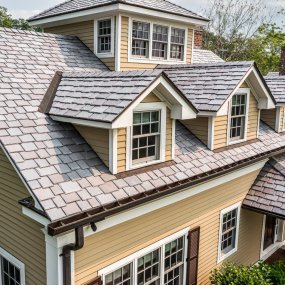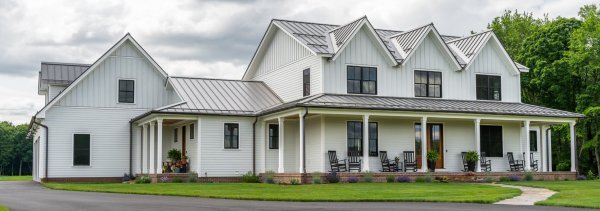50+ Years of Excellence: At Mr. Gutter, customer satisfaction is our top priority
We understand the importance of protecting your property from water damage, and that’s why we offer high-quality gutters and gutter guards that provide you with peace of mind. Our expertly designed gutters efficiently direct rainwater away from your building’s foundation, preventing soil erosion, basement flooding, and costly structural damage. With the added layer of protection from our durable gutter guards, you can say goodbye to the hassle of regular cleaning and maintenance. Trust Mr. Gutter to keep your property safe and secure, so you can focus on enjoying and maintaining your home or building. Your satisfaction is our guarantee!
“As a family-owned business with over 50 years of experience, our top priority at Mr. Gutter is ensuring 100% customer satisfaction. We take great pride in our work, and every installation we do reflects our commitment to excellence. From residential to commercial properties, our licensed and insured team of professionals delivers reliable and professional services. With our comprehensive warranties, we provide our customers with the peace of mind they deserve.”
Owner
Premium Gutter and Gutter Guard Installations in New England
Mr. Gutter has been specializing in the installation of gutters and gutter guards in New England for 50+ years. As a local, family-owned business, we take pride in our work and prioritize 100% customer satisfaction. We are fully licensed and insured, ensuring reliable and professional services for both residential and commercial properties. Our professional installers, and comprehensive warranties ensure that you’ll always have peace of mind.
Frequently Asked Questions
How do I know when my gutters need to be replaced?
There are several signs that indicate it may be time to replace your gutters. Here are some common indicators to look out for:
- Cracks or Splits: If you notice cracks or splits in your gutters, it’s a clear sign that they are deteriorating. These openings can lead to leaks and water damage to your home’s foundation or walls.
- Rust or Corrosion: Over time, gutters made of metal, such as steel or aluminum, can develop rust or corrosion. This not only affects their appearance but also weakens their structural integrity, making them more prone to leaks and failure.
- Sagging or Pulling Away: Gutters that are sagging or pulling away from the roofline indicate that they are not properly attached or have been subjected to excessive weight or stress. This can disrupt the proper flow of water and may require replacement.
- Peeling Paint or Water Stains: If you notice peeling paint or water stains on the exterior walls or fascia boards near your gutters, it could indicate that they are not effectively channeling water away from your home. This can lead to water damage and should be addressed promptly.
- Overflowing or Pooling Water: When your gutters are unable to handle the volume of water during rainstorms, you may observe water overflowing from the gutters or pooling around the foundation of your home. This suggests that the gutters are not functioning properly and may need replacement.
- Frequent Clogging: If your gutters are constantly clogged with debris, despite regular cleaning, it could indicate that they are old or damaged. Older gutters may have a less efficient design, leading to frequent clogs that can affect their overall performance.
- Age of the Gutters: Lastly, consider the age of your gutters. Most gutters have a lifespan of 20-30 years, depending on the material and maintenance. If your gutters are approaching or have exceeded their expected lifespan, it’s advisable to consider replacement.
What size gutters do I need for my home or property?
Determining the appropriate size of gutters for your home or property depends on various factors, including the roof area, rainfall intensity, and local building codes. Here are some general guidelines to consider:
- Roof Area: The size of your roof plays a significant role in determining the capacity of gutters needed. A larger roof area will require gutters with a higher capacity to handle the increased volume of water runoff. Measure the total square footage of your roof to estimate the appropriate gutter size.
- Rainfall Intensity: The average annual rainfall in your region is an important consideration. Areas with heavy or frequent rainfall will require larger gutter sizes to accommodate the higher water flow. Consult local weather data or consult with a professional to determine the rainfall intensity in your area.
- Roof Pitch: The pitch or slope of your roof can affect the speed at which water flows off the roof. Steeper roofs tend to generate faster water runoff, requiring gutters with a larger capacity to handle the increased flow.
- Local Building Codes: Check your local building codes or regulations, as they may specify minimum requirements for gutter sizes based on factors such as roof area and rainfall intensity. Adhering to these codes ensures compliance and helps prevent potential water-related issues.
- Downspouts: The number and size of downspouts also play a role in determining the overall gutter capacity. Downspouts provide an outlet for water to be directed away from the property. Ensure that the number and size of downspouts are sufficient to handle the water flow from the gutters.
Which gutter guard cover would you recommend on my house?
When choosing a gutter guard cover, there are several factors to consider:
- Type of Debris: Assess the type of debris that tends to accumulate in your gutters. Some gutter guard covers are better suited for specific types of debris, such as leaves, pine needles, or larger debris like twigs and branches. Choose a cover that effectively prevents the type of debris common in your area.
- Maintenance: Consider the level of maintenance required for the gutter guard cover. Some covers may require periodic cleaning or maintenance to ensure their effectiveness. Determine if you prefer a low-maintenance option or are willing to invest more effort in maintaining the gutter guard.
- Compatibility: Ensure that the gutter guard cover is compatible with your existing gutter system. Different gutter guard covers are designed to work with specific gutter types and sizes. Check the compatibility requirements of the cover to ensure a proper fit.
- Durability and Warranty: Look for a gutter guard cover that is durable and built to withstand the elements. Consider the material, construction quality, and any warranties provided by the manufacturer.
Will gutter guard covers stop my ice damming?
While gutter guard covers can help mitigate certain factors that contribute to ice dam formation, they may not completely eliminate the possibility of ice dams. Gutter guard covers primarily work by preventing debris from entering the gutters and obstructing water flow. By keeping the gutters clear, they help maintain proper water drainage and reduce the chances of ice dams forming.
Ice dams typically occur when heat from the interior of the house melts snow on the roof, which then refreezes near the eaves where the roof is colder. This refrozen ice can create a dam that prevents proper water drainage, leading to water backup and potential damage.
While gutter guard covers can minimize the accumulation of debris, they do not directly address the underlying causes of ice dams, such as inadequate insulation, ventilation, or heat loss from the home. To effectively prevent ice dams, it is essential to address these underlying issues through proper insulation, attic ventilation, and sealing air leaks.
Additionally, in extremely cold climates or during severe winter weather conditions, ice dams can still occur even with gutter guard covers in place. Factors such as heavy snowfall, prolonged freezing temperatures, or inadequate roof design can contribute to ice dam formation.
To best prevent ice dams, it is recommended to combine the use of gutter guard covers with other preventive measures, including proper insulation, ventilation, and addressing any potential heat loss issues. Consulting with a professional roofer or insulation specialist can provide tailored recommendations based on your specific circumstances to minimize the risk of ice dams.
How often do I need my gutters cleaned?
The frequency of gutter cleaning depends on various factors, including the surrounding environment, tree coverage, climate, and the type of debris that tends to accumulate in your gutters. While there is no set rule for how often gutters should be cleaned, here are some general guidelines:
- Twice a Year: For most homes, it is recommended to clean the gutters at least twice a year, ideally in the spring and fall. These seasons often bring a significant amount of debris, such as leaves, pollen, and twigs, which can clog gutters and hinder proper water flow.
- More Frequent Cleaning: Certain factors may require more frequent gutter cleaning. If your property has a high tree density or is surrounded by large, leafy trees, you may need to clean the gutters more frequently. Leaves can accumulate quickly and cause blockages, especially during the autumn season.
- Seasonal Inspections: Even if your gutters are not visibly clogged, it is a good practice to conduct visual inspections throughout the year. Look for any signs of debris accumulation, sagging gutters, or overflowing water during rainstorms. If you notice any issues, it’s recommended to clean the gutters promptly to prevent further damage.
- After Severe Weather: Following severe weather events, such as heavy storms or high winds, it’s advisable to check and clean the gutters as necessary. Storms can bring additional debris or dislodge existing blockages, which can affect gutter performance.
- Regular Maintenance: Regular gutter maintenance involves not only cleaning but also inspecting the gutters for any signs of damage, loose brackets, or leaks. Consider including gutter maintenance as part of your overall home maintenance routine, and address any issues promptly.
Remember that these are general guidelines, and the frequency of gutter cleaning may vary depending on your specific circumstances. It’s important to observe the condition of your gutters regularly and adjust the cleaning schedule accordingly. If you’re unsure about the appropriate cleaning frequency, it’s recommended to consult with a professional gutter cleaning service who can assess your property and provide personalized recommendations based on your specific needs.

Browse Mr. Gutter's Product Line
Explore our comprehensive residential, industrial and commercial gutter systems and extensive product line.


